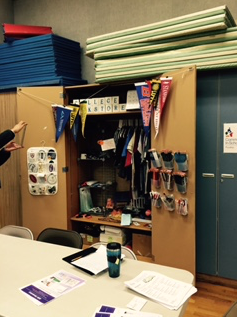Show Me, Don’t Tell Me
 AVID Center
AVID Center  Thursday, October 15, 2015 at 1:58PM
Thursday, October 15, 2015 at 1:58PM By Pamela Good, Program Manager, AVID Elementary, AVID Western Division
Have you ever read an article or seen a news story about a school that is doing amazing work with its students—achieving outstanding results, forming community connections, and inspiring its educators—and you finish this story with a smile on your face, but are often left wondering, “Well, how did they do that? I want to try it.” Hearing about a school’s success is quite different from seeing it and being able to ask those folks how they’re helping their students succeed. AVID Showcases are designed to help you do exactly that.
As the AVID Elementary (AE) Program Manager for the Western Division, I worked with Principal Arturo Gonzalez and Dr. Christine Moloney, the AVID District Directors-Elementary in Puyallup, WA, to showcase Karshner Elementary School this past March. With 61% of the student body qualifying for Free and Reduced Lunch, 56% Hispanic, and 29% ELL, the schoolwide AVID Elementary strategies have made a significant impact in accelerating academic performance at the school. Principal Gonzalez shared with me that they have seen a measurable increase in their state testing scores for students in grades 3–5 since implementing AVID Elementary, and the AVID Elementary system is aligned to the implementation of the Common Core State Standards. Karshner Elementary School is a stellar example of a strong AVID Elementary School, where all of their initiatives are aligned with AVID Elementary.
There are several essential components that we try to include at our AVID Showcases, including strong involvement of the AVID Elementary site team, classroom visits with opportunities to see evidence of student work based on AVID WICOR strategies, rigorous instruction, a visible classroom college-going culture, and some refreshments (of course). In addition, we like to have a short presentation that includes district office voices and the principal describing the school’s journey in implementing AVID and its impact on student learning. We also want to make sure that a panel of students and staff is present to share their experiences—ready and willing to answer questions from the visitors.
Visual commitments of a college-going culture are everywhere, with college corners, four-year college pennants, banners, and flags. These are what AVID Showcase attendees first saw when they entered Karshner. They heard the walls speak!
The Karshner showcase included a welcome from Superintendent Dr. Tim Yeomans and Chief Equity and Achievement Officer Gerald Denman. Next, we visited AE classrooms, looking at the student planners, three-ring notebooks, and evidence of student work that demonstrated student understanding of Costa’s Levels of Thinking and Questioning, one-pagers, student writing samples of reflections, quick writes, summaries, and in one class, students were in the process of having a Socratic Seminar. In some of the classrooms, teachers set out student notebooks and planners for the visitors to review. In others, we heard students working in teams, asking each other Level 2 and 3 questions based on a text that they were reading. In yet other classrooms, we saw informational text, where students had highlighted and underlined key vocabulary and main ideas. The visitors were busy taking pictures of anchor charts, examples of completed planners and reading logs, writing journals, and three-ring notebooks.
 When possible, we would encourage AVID Showcase attendees to talk to students and ask them about their goals, what colleges they are considering, or what the most interesting part of creating a one-pager was. The visit concluded with a light lunch, followed by a student and teacher panel and a visit to the “college bookstore.” Colleges and universities from across the United States donated all of the items in the bookstore. Students wrote letters to the schools, requesting donations, and boxes started arriving. Schools sent a variety of items from small pennants, key chains, and bracelets, to larger items, like T-shirts and large pennants. Students can purchase these items with tokens that they earn for outstanding classroom behavior and personal accomplishments. Items cost one, two, or three tokens, and the kids save them like they are golden nuggets.
When possible, we would encourage AVID Showcase attendees to talk to students and ask them about their goals, what colleges they are considering, or what the most interesting part of creating a one-pager was. The visit concluded with a light lunch, followed by a student and teacher panel and a visit to the “college bookstore.” Colleges and universities from across the United States donated all of the items in the bookstore. Students wrote letters to the schools, requesting donations, and boxes started arriving. Schools sent a variety of items from small pennants, key chains, and bracelets, to larger items, like T-shirts and large pennants. Students can purchase these items with tokens that they earn for outstanding classroom behavior and personal accomplishments. Items cost one, two, or three tokens, and the kids save them like they are golden nuggets.
A group of visitors from one of the neighboring districts that is currently implementing AVID Elementary in grades 4–5 sat together as a team, discussing what they were going to take back to their school, what pictures they were going to share that demonstrated how AVID is being implemented at grades K–3, and the process of getting all of their staff trained in AVID Elementary. Another group was excited that they had already decided to implement AVID Elementary, and they were wondering if they should take a closer look at their school’s mission/vision statement and make sure that it is aligned to AVID Elementary before they go to Summer Institute.
All in all, it was a productive day for everyone. The AVID Showcase was over, but visiting teams were still there talking, sharing what they saw, and planning their next steps. This is just one example of the college-going culture on display at the four AVID Elementary Showcases that we highlighted this past school year in the Western Division.
Below you will find links that highlight our Arizona and Oregon AVID Elementary Showcases:
Sacramento Elementary School, Parkrose School District, Portland, OR
Porter Elementary School, Mesa Public Schools, Mesa, AZ
Look out for the next AVID Showcase in your area! They're held at both elementary and secondary AVID sites!
___________________________________________________________________________________________
 Pamela Good is the AVID Elementary Program Manager in the Western Division. She is a former Principal of an AVID National Demonstration School, Hoover High School in Glendale, CA and Assistant Director of Curriculum and Instruction at the Los Angeles County Office of Education (LACOE).
Pamela Good is the AVID Elementary Program Manager in the Western Division. She is a former Principal of an AVID National Demonstration School, Hoover High School in Glendale, CA and Assistant Director of Curriculum and Instruction at the Los Angeles County Office of Education (LACOE).
For more on AVID, visit AVID.org.
Reader Comments